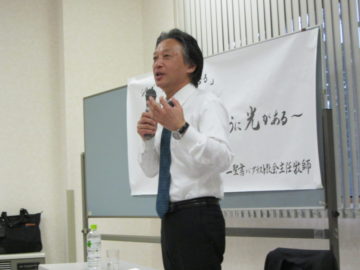(Below are some quotes from the video)
The area near our church became like this. No one lives there anymore.
Here are some testimonies of the kids who attended our church. They are first graders.
This is a dosimeter.
This is a row of cherry trees near my home.
At present, this is the danger zone where you have to wear protective clothing to enter. The zone is divided into two: one is the zone where you can visit during the day, but overnight stay is prohibited. The other is the zone where you wait and prepare yourselves for return when the evacuation order is lifted. But they are all ghost towns. We can’t enter without the protective clothing.
(End of the Video)
The Church in the Midst of the Disaster
Well, now, I would like to show you some pictures of our church. Our church was built in a countryside by this 25-year-old American missionary. He went through countless hardships to create a strong foundation of the church. In those days, the village was a migrant workers’ village. Eventually, the church built after I took up my pastoral care here, the cemetery, the other chapel which looks like Noah’s Ark were hit by the tsunami. This next chapel is a little bit cool. The last one is a chapel which was built before the earthquake. We put so much work into it, but all of these were closed immediately. And all of the people in this picture were dispersed all over Japan.
“What happened after the earthquake?” As you can see in this picture, everything was scattered all over, old houses, four or five houses past our church, were crushed in an instant, and the coastal town was destroyed by the tsunami. On the day following day, residents who could not get on the bus to evacuate were taken to a shelter on top of a mountain by trucks provided by the Self-Defense Force. The two people on the front right are parishioners of our church. When we arrived, we found that bathrooms were almost unusable and certain shelters were without blankets. Besides, it started to snow. Therefore, we, the parishioners and myself in ten and a few more separate cars, crossed over the pass of the winter mountains alongside the trucks and buses. We stayed at Aizu for two nights and then moved to Yonezawa in a blizzard. Although it was March, the ground was covered with one meter of snow. We only ate canned food for the first two weeks.
We soon realized that we simply could not live this way and decided to move to Tokyo. We stayed at a church-related campsite for a year. Missing our hometown very much, we moved to Iwaki, a city in the southern part of Fukushima prefecture. Just like the Exodus in the Old Testament, we traveled a total of 700 km, a distance of about one round trip around the Sinai Peninsula. It was a strange and wonder-full trip that the old and the young alike traveled together. Other parishioners settled in other prefectures like Gunma, Niigata, and Saitama. I think that our church was torn apart. Those who barely escaped the catastrophe with me slept crowded together in the same room. The memory of those days made them quiver mentally and physically. I cannot thank enough a German missionary who takes pastoral care of that campsite in Tokyo where we spent a year.
As it was reported on the news, the kids from Fukushima faced bullying. Therefore, during our stay in Tokyo, we prayed for them and they went to school from the campsite. We attend divine service every single day. In July of that year, we decided to head back to Fukushima and said our farewell in tears. There, a year after the earthquake, we built “El Shalom,” a house where the elderly can peacefully live side by side. The following year, driven by necessity of building a new chapel, we built and dedicated “the Chapel of Wing,” a chapel in the shape of a bird’s wing flying back toward our hometown. Nowadays, it is a gathering place for the locals from which I take great comfort. Just beyond the mountains in this picture lies our dear hometown. And now, please watch a TV program which documented our journey of the year since the calamity of the earthquake.
(From here is the video)
-Our time at Okutama is shown.
Next is a clip from the broadcast a year after the first showing. It is quite long, so I will only show you the final scene.
-The video of the completion of the construction of “the Chapel of Wing” is shown.
(The end of the videos)
Thank you for watching a long video.

